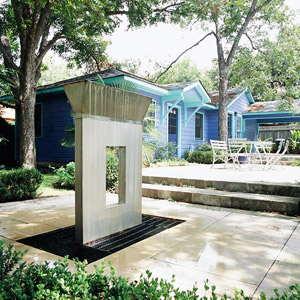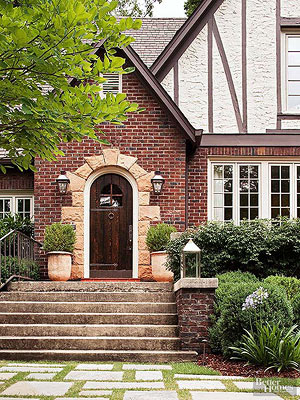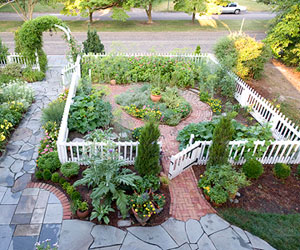
Plants may outnumber landscape materials, but that doesn’t mean you can’t use the nonplant pieces in your landscape to complement a garden’s design. Here’s a landscape materials primer and some smart selection tips for paving, edging, and creating paths and walls.
continue reading below
Concrete

The Basics: Concrete is among the most cost-effective and long-lasting landscape materials. It must be formed, poured, finished, and cured quickly. However, concrete shouldn’t be used in spots where the ground may move or heave — for example, around a tree that can push it up and out or in an area that doesn’t properly drain. Concrete should also be cleaned regularly to prevent stains from oil and grease, mildew, or rust.
Test Garden Tip: No matter how carefully it is poured, concrete will eventually crack to some degree. Any cracks smaller than 1/2 inch wide usually don’t pose a problem. If the crack is dormant — meaning it no longer widens or lengthens — it is probably OK too. Typically cracks not in buildings can be patched or resurfaced with a variety of products and kits such as epoxy mix, glue, or stain and rust removers; in the worst cases, the areas may have to be repoured.
Asphalt
The Basics: Asphalt is made from crushed rock mixed with bitumen, a sticky petroleum byproduct. Asphalt should be kept clean of moss, dirt, and debris, and needs to be resealed every three or four years.
Test Garden Tip: Both ultraviolet rays from the sun and heat degrade the bitumen in asphalt, which weakens its resistance to water. Numerous cracks, a wavy surface, wheel ruts, and potholes are a good indication that asphalt is in distress. Products to seal or repair asphalt should be either asphalt- or coal tar-based, with a warranty of four to six years. Liquid crack fillers work well for very small cracks no wider than 1/8 inch.
Brick, Pavers, Flagstone, and Rock

The Basics: Brick, flagstone, and interlocking pavers are durable and classic landscaping materials; they can be mortared in place or more casually laid directly on sand or crushed rock (heaving is often less of a problem in the North if you lay them directly into a base without using mortar). To maintain them, inspect regularly for broken or loose mortar or paving units and replace as soon as possible. Mildew is unsightly and slippery and should be removed, as should moss and algae in moist, shaded spots. Mortared-in-place pieces can be broken out and fixed with new pieces. If areas become displaced, relevel them with sand.
Bricks are made of clay and come in a variety of colors as well as half-thicknesses. While less expensive, concrete bricks have a coarse finish and dull uniformity. Bricks can also be repurposed or reclaimed from other projects, but may have to be cleaned of old mortar. Common or building bricks are made of clay and designed for the inner layer of a brick wall. They are not long-lasting choices for outdoor paths or patios. Face bricks, a higher quality, have a smooth face that resists weathering.
Test Garden Tip: Bricks are graded by their ability to withstand weather: SW (withstand severe weathering and below freezing), MW (withstand freezing in dry climates), and NW (no freezing and low rainfall).
Use bricks to create retaining walls; find out our maintenance tips here.

Flagstone and bluestone are widely used for pathways and patios. They work best set in mortar but can be bedded in sand or crushed rock and need only sweeping and periodic washing. These landscape materials have a natural look.
Concrete pavers are manufactured in different patterns, many of which interlock for stability. Less expensive than brick or flagstone, concrete pavers can also be laid in place quickly on any smooth, firm surface.
Test Garden Tip: Interlocking pavers do not need to be set in mortar, and they don’t require a border to hold them in place.
Crushed rock is a great choice for a patio or walkway. However, it needs a rigid border to keep the material in place, but is better than gravel for walking because its irregular edges lock firmly together, unlike rounder and smoother gravel, which rolls underfoot and does not stay in place.
SOURCE:http://www.bhg.com/gardening/landscaping-projects/landscape-basics/landscape-materials-guide/